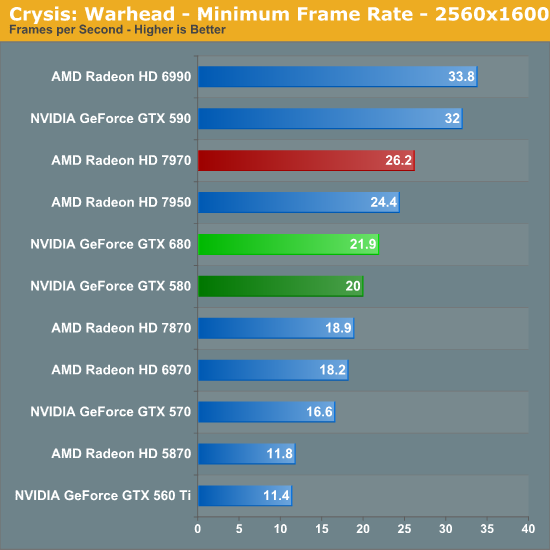NVIDIA GeForce GTX 680 Review: Retaking The Performance Crown
by Ryan Smith on March 22, 2012 9:00 AM ESTCrysis: Warhead
Kicking things off as always is Crysis: Warhead. It’s no longer the toughest game in our benchmark suite, but it’s still a technically complex game that has proven to be a very consistent benchmark. Thus even four years since the release of the original Crysis, “but can it run Crysis?” is still an important question, and the answer continues to be “no.” While we’re closer than ever, full Enthusiast settings at a 60fps is still beyond the grasp of a single-GPU card.



While Crysis was a strong game for the GTX 580, the same cannot be said of the GTX 680. NVIDIA is off to a very poor start here, with the Radeon HD 7970 easily outperforming the GTX 680, and even the 7950 is tied or nearly tied with the GTX 680 depending on the resolution. On the bright side the GTX 680 does manage to outperform the GTX 580, but only by a relatively meager 17%.
Given the large gap in theoretical performance between the GTX 680 and GTX 580, as it turns out we’ve run into one of the few scenarios where the GTX 680 doesn’t improve on the GTX 580: memory bandwidth. In our overclocking results we discovered that a core overclock had almost no impact on Crysis, whereas a memory overclock improved performance by 8%, almost exactly as much as the memory overclock itself. When it comes to the latest generation of cards it appears that Crysis loves memory bandwidth, and this is something the Radeon HD 7900 series has in spades but the GTX 680 does not. Thankfully for NVIDIA not every game is like Crysis.



The minimum framerate situation is even worse for NVIDIA here, with the GTX 680 clearly falling behind the 7950, and improving on the GTX 580 by only 10%. At its worst Crysis is absolutely devouring memory bandwidth here, and that leaves the GTX 680 underprepared.










404 Comments
View All Comments
maximumGPU - Saturday, March 24, 2012 - link
"The benchmarks are tight in front of your faces!"and judging by your conclusion it seems you didn't even read them..
Skiddywinks - Saturday, March 24, 2012 - link
"The benchmarks are tight in front of your faces! "No s***, Sherlock.
"The 680 is tied with the 7950, which surpasses it by a little, and the 7970 is the leader. "
Clearly the benchmarks in front of my face are different to the ones in front of your face.
BoFox - Monday, March 26, 2012 - link
I know, that's why I'm telling him that Anandtech Forum is a perfect place for him!BoFox - Monday, March 26, 2012 - link
Then you'll love Anandtech Forums!! It's the perfect place for you! They'll love you over there!CeriseCogburn - Tuesday, March 27, 2012 - link
It's absolutely amazing isn't it.SR81 - Saturday, March 24, 2012 - link
HardOCP has surround benches on both the 680 and 7970, surprisingly the lower bandwidth/VRAM card wins even with 4XMSAA and FXAA enabled at 5760x1200 (ex.Skyrim: 680 = 58.6, 7970 = 45.4)When Anand updates this review with surround benches it will leave no doubt which card is the absolute king. I think the articles title is rightfully deserved once testing is done :)
CeriseCogburn - Saturday, March 24, 2012 - link
Yep, saw it like 2 days ago, the ram arguments have been foolish once you crank eye candy high enough (on weak ram cards) both comps frame rates are too low to matter.dtolios - Saturday, March 24, 2012 - link
I know the AMD vs. Nvidia war is a hot topic in Anandtech - just like any other tech forum/review site etc - but one of the really hard applications for modern GPUs is production rendering acceleration.There are multiple instances were you can see reviewers trying to compare different GPUs, different architectures, SLI combinations (or just multiple GPU) combinations etc while using GPU accelerated renderers, a professional application that is relying more and more on "game" oriented boards instead of Quadro / FireGL versions (unless vram limitations get in the way).
Testing on applications like Octane Rendered, Vray 2 GPU, iRay etc, would be a nice addition to your tests - not only because those are hard to find and easily more intensive than "just gaming", but also because few sites have access to such an extensive line of hardware to pull a realistic comparison, including multiple GPUs, different generations, scalability with multiple cards etc. The only "comparison tables" you can easily find, are from people sharing their personal observation on their blog or forum - under not that repeatable conditions etc...
For some apps, Open CL could be nice to keep on the AMD vs. nVidia "hype" going on, but sadly for some of us, most of these renderers are either exclusively CUDA based, or run better on it, so it would be nice to actually do core comparisons even within the nVidia line: you see, in rendering applications, getting better scalability with multiple cards, or removing 30min out of your 2hour rendering workflow is way more important than gaining 5% FPS advantage over the other card.
You do include 3DS or similar productivity comparisons in your CPU reviews, so it only make sense to include it for your GPUs too.
poordirtfarmer2 - Monday, March 26, 2012 - link
I agree wholeheartedly! I’d love to pick the best “gaming” card for also doing pro work. Although just an amateur, I actually find myself spending more time editing and rendering videos than I do playing games.AnnonymousCoward - Saturday, March 24, 2012 - link
When 2560x1600 4xAA results in way under 60fps, IMHO it's not a very useful benchmark. Any user would go to 2xAA or no AA, to get 60fps. So who really cares how these cards compare at a setting that's never used.